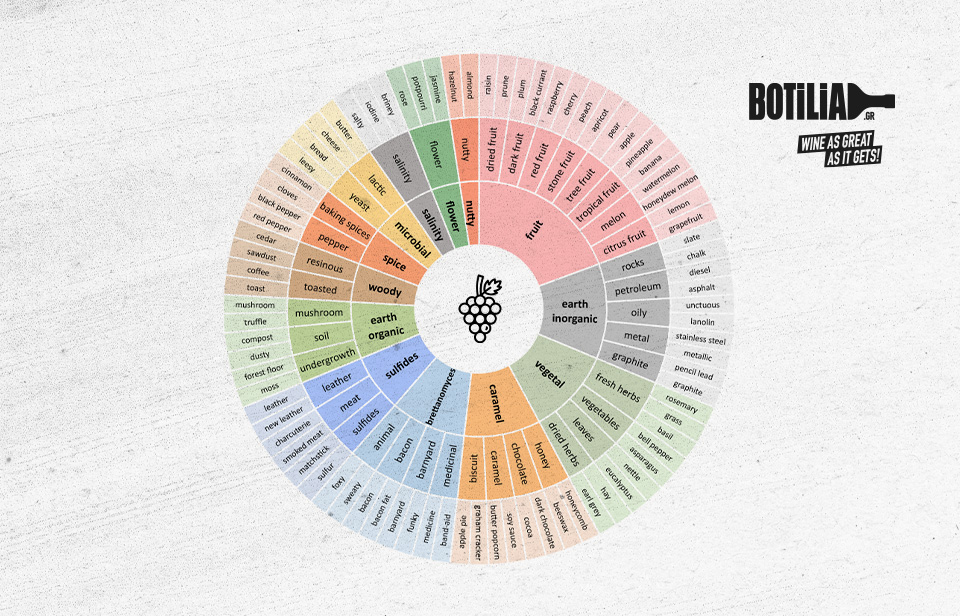THE WINE AROMA WHEEL

You took the big step and went to that winetasting course and things became a little more complicated than before. At the restaurant, the sommelier suggests you order the proper wine according to its aromas, or not go too far, you are at botilia.gr website and read our detailed descriptions of the aromas in each one before you buy it. After this it reaches your glass, questions jump into your mind and you wonder "but where did they find all these aromas?", "how do they recognise them?".
To begin with, let us tell you that finding aromas in wine is not nuclear physics and no one was born automatically with this ability programmed into their software. Things are much simpler than they seem and behind them, there is constant practice, but also some tools that are the holy grail of tasting. One of them is the UC Davis Wine Aroma Wheel.
When and why was it created?
Behind the aroma wheel is the chemist Ann Noble, who after her PhD in Food Technology at the University of Massachusetts, accepted the position offered to her in 1974, in the Department of Viticulture and Oenology at the University of California, Davis. This in itself was quite innovative for the time, as she was the first woman to hold such a position at a prestigious educational institution.
Ann realized then that while many were involved in wine industry and tastings, it was all based on personal opinions. The result was the creation of chaos and a lot of questions since all the wines were described as "not good", "elegant" and "harmonious", which did not help the consumer and certainly not sales. So she decided to overcome the ambiguities about aromas by creating a terminology that would be understood by everyone and would be widely accepted and simple. In essence, she made a list of aromas, which resulted in a more complete grouping of them.
And while it may sound simple, in practice it was a bit more complicated, since she would have to combine more than one science. Chemistry played a dominant role, while biology and psychology completed the puzzle and solved many questions. Lab animals were of course a group of people who did continuous tastings and recorded their reactions as they tasted specific characteristics of the wine.
What exactly does it include and how can it be used in practice?
As we have analyzed in a previous article, the basic steps of tasting are sight, smell, and taste. The wine aroma wheel was made to address only the second stage but was then used by many for the tasting stage as well. It is a very detailed palette of the possible aromas that one can recognize when smelling a wine.
Noble collected all the recognizable aromas of the wines after the experimental tests and initially categorized them into those most common to whites and reds. Then some oenologists and vintners put their hand in to strengthen the terminology even more, to jointly arrive at words that represented them better and more comprehensively.
After all this, the final form of the wheel was created which includes 3 concentric circles that radiate from the inside out, guiding you to arrive at a very detailed and accurate result. The first circle includes a general division of aromas into basic categories, for example fruity, floral, botanical, chemical, etc. The next one gives more information about the original scent. For example, fruity aromas can be citrus, tropical, stone fruits, etc. And finally, the largest outer circle gives an even more detailed description of the immediately preceding second circle. That is, tropical fruit can be pineapple, mango, banana, or melon. In other words, starting from the center, you recognize a characteristic and see where it can lead you. Here, of course, you take a lot of notes with what you recognize, but in the end, reading what you have written, you will see that you have made a very detailed description. Perfect?!
Originally the inner circle included 11 different categories of fragrances, but then some subcategories were deemed appropriate to form a category by themselves, resulting in a total of 13 today. And if you consider the subsequent subcategories of the outer circles, you will now understand that some aroma descriptions of the wines we do are already too laconic!
Is this wheel useful or not?
Wine tasting can start from something very simple and develop into a big maze. The aroma wheel has evolved and now there are counterparts for each grape variety separately! Each wine has the unique aromas of the grape from which it is produced which is a combination of soils, climate, and of course winemakers.
Taste and smell have always influenced and will influence our choices. But taste perceives only 5 different categories, while smell over 10,000! This means that over 80% of what we think we taste, comes from smell!
So tools like this make the life of sommeliers, beginners in tasting, and those who just want to enjoy a wine, easier with this common communication code. And the way to achieve that is continuous testing. Whether you just enjoy a nice wine with your meal or want to play the tasting game, keep trying different wines but always, as Ann Noble says, "listen to your nose"!
Christina Tsogka


